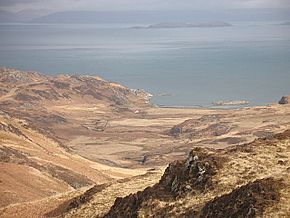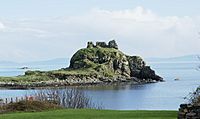Battle of the Western Isles facts for kids
Quick facts for kids Battle of the Western Isles |
|||||||
|---|---|---|---|---|---|---|---|
| Part of Clan Maclean and Clan MacDonald feud | |||||||
 Glen Garrisdale, a former stronghold of the MacLeans of Jura |
|||||||
|
|||||||
| Belligerents | |||||||
| Clan Maclean | Clan Macdonald of Sleat Clan MacDonald of Dunnyveg |
||||||
| Commanders and leaders | |||||||
| Lachlan Mor Maclean | Donald Gorm Mor of Sleat Angus MacDonald of Islay |
||||||
The Battle of the Western Isles was a series of fights that happened in 1585 and 1586. These battles took place on several islands in Scotland, including Jura, Islay, Mull, and Tiree. They also happened on the Kintyre peninsula on the mainland. Even though the old records call this the "Western Isles" (which are now known as the Outer Hebrides), all these places are actually in the Inner Hebrides. The main groups fighting were the Clan Macdonald of Sleat and Clan MacDonald of Dunnyveg against the Clan Maclean.
The conflict started in 1585. The Macleans attacked a group of MacDonalds of Sleat. This happened because the Macleans wrongly thought the MacDonalds had stolen their cattle. The MacDonalds of Sleat and Dunnyveg then fought back to get revenge. King James VI of Scotland tried to stop the fighting, but the battles continued into 1586. Eventually, the King and his council passed a special law called an Act of Parliament. This law said that clan chiefs who did not keep peace among their people (called vassals) would have to pay fines.
Contents
The Conflict on Jura Island
In the summer of 1585, Donald Gorm Mor of Sleat, who was the chief of the Clan Macdonald of Sleat, traveled from the Isle of Skye. He was going to visit Angus MacDonald of Islay, chief of the Clan MacDonald of Dunnyveg. A big storm forced Donald Gorm Mor to find shelter on the northern part of the Isle of Jura. This part of Jura belonged to Lachlan Mor Maclean, the chief of Clan Maclean. Lachlan Mor Maclean lived at Duart Castle on the Isle of Mull.
Another group of MacDonalds, led by Hugh and Donald Herrach, were also caught in the same storm on Jura. These two men decided to cause trouble. They stole many cattle belonging to the Macleans who lived nearby. They hoped the Macleans would blame Donald Gorm Mor for the theft. They wanted the Macleans to attack him.
The Macleans whose cattle were stolen went straight to Lachlan Mor Maclean to complain. Lachlan Mor Maclean quickly sailed to Jura with his men. He launched a surprise attack on Donald Gorm Mor, who had no idea what had happened. In the fight, Lachlan Mor Maclean's men killed sixty of the MacDonalds. However, Donald Gorm Mor and the rest of his men managed to escape. The punishment Lachlan Mor Maclean gave was very harsh.
Donald Gorm Mor returned to Skye, determined to get revenge on the Macleans. He sent messages to other Clan Donald leaders, asking them to help him attack the Macleans. Even after finding out that other MacDonalds had stolen the cattle, the MacDonalds were still very angry about their clansmen being killed. They refused to make peace with Lachlan Mor Maclean.
The King Steps In
In September 1585, King James VI of Scotland wrote to the Chief of the Clan MacLeod. He asked them to help the Macleans against the MacDonalds. At the same time, he urged the MacDonalds to stop fighting. Because of the King's request, the MacDonalds decided to try and settle their disagreements peacefully.
In the spring of 1586, Angus MacDonald of Islay went to Skye. He met with Donald Gorm Mor to discuss a peace agreement with Lachlan Mor Maclean. On his way back, Angus stopped at Duart Castle to try and reach a friendly agreement with Lachlan Mor Maclean. But the next day, Maclean captured Angus and his followers. He put them in prison. Angus was forced to agree to give up his claim to an area called the Rinns of Islay. Angus also had to give his son, James, and his brother, Ranald, as hostages to Lachlan. These hostages would stay with Lachlan until he received the lands he was promised. Angus was treated very badly by Maclean. This made him return to Islay as a bitter enemy.
Fighting on Islay, Mull, Tiree, and Kintyre
In July 1586, Lachlan Mor Maclean went to Islay to take control of the Rinns. He stayed at the fort of Lochgorm for three days. Angus of Islay repeatedly invited him to visit at Mullintrea. Maclean finally agreed to spend a night with Angus. He brought about seventy or eighty-six followers with him. Maclean was welcomed in a friendly way and given a grand meal. However, he refused to sleep in Angus's house. Instead, he went to sleep in one of the buildings where his followers were staying. He also took James, Angus's son, who was still a hostage, with him.
At midnight, Angus of Islay, with 400 armed followers, went to the building where Lachlan Mor Maclean was sleeping. He asked Maclean to come out for a drink. Maclean came to the door with the hostage James in one hand and a sword in the other. He saw that he could not escape. Angus realized that if a fight started, his own son would surely be killed. Angus promised that if they gave up his son and surrendered as prisoners, their lives would be saved. Maclean accepted this offer, and so did all but two of his men. These two men were John Dubh of Morvern and MacDonald Herrach. MacDonald Herrach was one of the men who had caused the first fight by stealing Maclean's cattle. These two men refused to leave the building. So, the MacDonalds set fire to it, and they died in the flames. All the other prisoners were killed, except for Lachlan Mor Maclean himself.
These terrible actions reached the King's attention. The King asked the chiefs of the Clan Campbell, who were in charge of Argyll, to help make peace between the clans. Angus MacDonald agreed, but only if he was forgiven for his crimes. He also demanded that eight hostages from Maclean be given to him. Maclean was forced to agree. After this, MacDonald went to Ireland. While he was away, Maclean ignored the hostages. He invaded Islay with his clan and destroyed everything with "fire and sword." When MacDonald returned, he did not harm the hostages. Instead, he gathered a large army and invaded the islands of Mull and Tiree. They killed everyone they found. Meanwhile, Maclean attacked and robbed Kintyre.
What Happened Next
The government felt they had to act quickly to stop these serious problems. The King and the Privy Council of Scotland (a group of royal advisors) issued an order. It said that the hostages had to be given to the young Earl of Argyll, or his guardians. They would then bring the hostages to the King until the dispute between the MacDonalds and Macleans was finally settled. The two clans and their supporters were told to stay calm. They were ordered not to gather in arms or attack each other.
The King also wrote to the Earl of Huntly. He asked him to stop the northern islanders from fighting. The King said he planned to take "special pains" to fix the problems in the Isles, just as he had recently done in the Borders.
A new Act of Parliament was also passed. This law was meant to keep good order in both the Borders and the Highlands and Isles. It stated that all clan chiefs had to promise to keep the peace. They had to provide large amounts of money, based on their wealth, to guarantee that they and their people would behave peacefully. According to an old book called Conflicts of the Clans, both Angus MacDonald and Lachlan Mor Maclean were put in Edinburgh Castle. They stayed there for only a short time. They were then freed after paying a small fine and were forgiven for their actions. However, their oldest sons had to remain as a promise of their good behavior.




